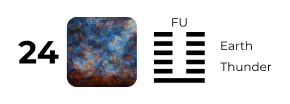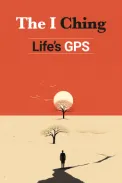What is Hexagram 24?
'Return' in the I Ching symbolises embracing change and returning to one's roots. It advocates letting go of hindrances and staying true to values. The hexagram represents finding stability in familiarities, encouraging acceptance, humility, and discipline. It's a time for self-reflection, rediscovery, and reconnection, highlighting cautious transformation and the importance of returning to one's true self.

I Ching Hexagram 24 - Return
Embrace change, let go of what's holding you back, and stay grounded in your values. Don't fear the end of something, as it can pave the way for a fresh start.
Summary
The hexagram represents the return to one's roots and finding stability in familiar surroundings. It consists of two trigrams signifying a journey's end and a return to the starting point.
Interpretation
The hexagram encourages a return to our true selves and path of acceptance, humility, and discipline. It prompts us to let go of old belief systems, defence mechanisms, and ego-centric expressions blocking growth. It's a time for rest, self-reflection, rediscovery, and reconnection with our roots. The emphasis is on cautious steps, change, and transformation.
Line 1
Early recognition and correction of straying from the right path is essential. Confronting doubts early on can prevent further deviation.
Line 2
Pride can lead to danger. Patience, tolerance, and humility bring good fortune.
Line 3
Avoid immediate resolution demands and remain patient to reach your goals. Shed your resistant attitude for progress.
Line 4
Stay true to your principles, even if you're alone in doing so. Inner peace and a strong sense of self are your rewards.
Line 5
Take responsibility for actions, recognise mistakes, and correct them. This is the noble-hearted path of Return.
Line 6
Missing the moment of Return can lead to misfortune. It's vital to self-examine, correct wrong attitudes, and seize opportunities when they arise.
Note: This is a summarised version. For the complete version, get the app.
Unveiling the Wisdom of Hexagram 24: A Guide to Personal Transformation
Dive into the ancient teachings of I Ching Hexagram 24, as we uncover its profound wisdom and its application to self-improvement, personal growth, enlightenment, and awakening. This exploration is not just an academic exercise but a practical guide to integrating timeless truths into our modern lives, fostering transformation and deeper understanding of our personal journeys.
Core Insights
Essence of Hexagram 24
Hexagram 24, often referred to as “Return” or Fu, symbolises the idea of returning to the beginning, renewal, and the cyclical nature of life. It represents the fundamental principles of introspection, regeneration, and the renewal of commitments or efforts. This hexagram reflects the journey back to one’s roots or core values, signifying a time of rejuvenation and new beginnings.
Historical Wisdom
Throughout history, Hexagram 24 has been interpreted as a sign of hope and the promise of a fresh start. It serves as a reminder that after a period of decline or wandering, there is always an opportunity to return to what is essential and true. This hexagram has been applied in spiritual contexts and personal development, emphasising the importance of self-reflection and recommitment to one's path.
Personal Growth and Self-Improvement
Reflective Questions
- What aspects of my life or self might benefit from a process of renewal or return to core principles?
- How can I cultivate a practice of introspection to guide my journey of personal transformation?
- In what ways can I reconnect with my core values or true self as I navigate life’s complexities?
Actionable Insights
- Create a regular practice of self-reflection, such as journaling or meditation, to explore your inner landscape and reconnect with your core values.
- Identify areas in your life where a return to basics or a renewal of efforts is needed, and take deliberate steps toward that goal.
- Embrace the concept of cyclical growth and renewal, recognising that periods of decline are often followed by opportunities for significant personal development.
Path to Enlightenment
Mindfulness Practices
Engage in mindfulness techniques that focus on the theme of renewal and returning to the self. Practices like meditations on grounding, centring, or practices that encourage a reconnection with one’s inner wisdom are aligned with Hexagram 24.
Philosophical Reflections
Reflect on the significance of returning and renewal in the journey of life. Explore the idea that returning to one's origins or core values is a pivotal step in achieving greater awareness and enlightenment.
Awakening to Life’s Mysteries
Transformational Stories
Share stories that embody the essence of Hexagram 24. These could include personal anecdotes where a return to core principles led to significant change, historical examples of rejuvenation and renewal, or parables that highlight the value of introspection and recommitment.
By exploring the wisdom of Hexagram 24, we embark on a journey of rediscovery and renewal, guiding us towards a deeper understanding of our true selves and the potential for transformation in the cycles of our lives.
More Information about the I Ching
Understanding the Structure of Hexagrams
Every hexagram in the I Ching, from the first hexagram to the 64th, is constructed using a combination of trigrams. These trigrams, the building blocks of every I Ching hexagram, represent different natural elements and concepts, such as wind, water, fire, and mountain. The upper trigram and lower trigram interact, giving birth to the unique energy of the hexagram. By delving into the trigrams that compose a hexagram, one can unearth its deeper meanings and implications.
The Timeless Nature of I Ching
The I Ching, often referred to as the Book of Changes or Yijing, has remained relevant due to its universal themes. While society has evolved, the essential human emotions and challenges we face remain. The 64 hexagrams of the I Ching address these timeless concerns, making it an untiring guide for introspection and growth. Whether you're contemplating the creative power of Hexagram 1 or the dynamic interplay in other hexagrams, the wisdom remains ceaseless.
The Philosophical Foundations of I Ching
The I Ching is deeply rooted in Taoist and Confucian philosophies. It's a reflection of the world's natural order, emphasising the dynamics of yin and yang. Studying the hexagrams provides insights into the ancient Chinese understanding of balance, change, and harmony in the universe.
How to Consult the I Ching
Traditionally, seekers would consult the I Ching using yarrow stalks or coins. The divinatory process, often seen as an interaction with the oracle, results in a specific hexagram. This hexagram, whether it be the light-giving Hexagram 1 or another, provides guidance tailored to the individual's query. Modern enthusiasts might also opt for a free I Ching reading online to understand their current situation better.
Incorporating I Ching Hexagram 24 into Daily Life
Hexagram 24, emblematic of the idea of return and renewal, brings forth wisdom on rejuvenation and the cyclical nature of life. The six lines of this hexagram celebrate the rhythms of existence, from decay to rebirth. In our journey through life's highs and lows, Hexagram 24 serves as a reminder of the promise of new beginnings, encouraging us to embrace opportunities for renewal and growth.
Incorporating I Ching into Self-Improvement and Personal Growth
The I Ching, with its intricate tapestry of hexagrams, serves as a profound compass for those on a journey of self-improvement and personal growth. Each hexagram offers insights into life's challenges and opportunities, guiding individuals to introspect, evolve, and align with the universe's natural rhythms.
Regularly consulting the I Ching offers a bridge to ancient wisdom, helping seekers tap into their inner strengths and potentials. The detailed interpretations of each hexagram, from the dynamics of its yang and yin lines to its overarching message, act as roadmaps for personal development. They shed light on one's strengths, highlight areas for growth, and provide direction in times of uncertainty.
For those dedicated to personal evolution, the I Ching is an invaluable guide. It aids in discerning the optimal paths in life, understanding relationship dynamics, and fostering a harmonious balance in all endeavours. Through its teachings, individuals are equipped to cultivate essential virtues like patience, resilience, and empathy. This not only empowers personal growth but also enables one to be a positive force in the broader world.
In today's rapidly changing world, the I Ching remains a pillar of timeless wisdom. It beckons individuals to journey inward, embrace continuous learning, and cherish the ever-evolving process of self-betterment.
Consult I Ching
Choose a Hexagram Number
How to use the coin method to consult the I Ching
Consult the I Ching online. Use our coin method simulation and build your own hexagram.
Useful Links
- Revolutionary I Ching App to harness Insights for Personal Growth, Download AI Ching App
- What is the I Ching
- How to consult the I Ching
- Consult the I Ching Online
- Discover the ‘Daily I Ching’ for universal guidance.
- Access all the I Ching Hexagrams 1 to 64
- Buy the book, Embracing Life’s Journey Your Guide to Personal Growth with the I Ching
- Little Panda Learns the Tao: Stories of Nature’s Balance. Download on Amazon
- Discover Inner Peace, one day at a time
FREE Ebook - The I Ching: Life’s GPS

The Ultimate Guide to Life's Answers
Unlock ancient wisdom. Discover how the I Ching can guide your decisions and bring clarity to your path—your answers await.






